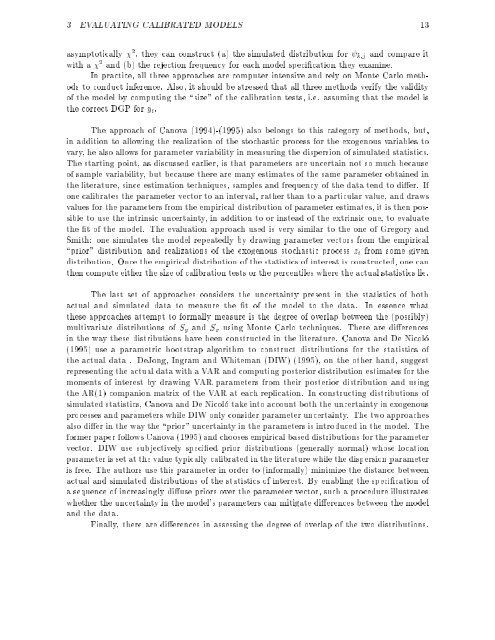Testing Calibrated General Equilibrium Models - Universitat ...
Testing Calibrated General Equilibrium Models - Universitat ...
Testing Calibrated General Equilibrium Models - Universitat ...
Create successful ePaper yourself
Turn your PDF publications into a flip-book with our unique Google optimized e-Paper software.
3 EVALUATING CALIBRATED MODELS 13<br />
asymptotically 2 , they can construct (a) the simulated distribution for kj and compare it<br />
with a 2 and (b) the rejection frequency for each model speci cation they examine.<br />
In practice, all three approaches are computer intensive and rely on Monte Carlo methods<br />
to conduct inference. Also, it should be stressed that all three methods verify the validity<br />
of the model by computing the \size" of the calibration tests, i.e. assuming that the model is<br />
the correct DGP for yt.<br />
The approach of Canova (1994)-(1995) also belongs to this category of methods, but,<br />
in addition to allowing the realization of the stochastic process for the exogenous variables to<br />
vary, he also allows for parameter variability in measuring the dispersion of simulated statistics.<br />
The starting point, as discussed earlier, is that parameters are uncertain not so much because<br />
of sample variability, but because there are many estimates of the same parameter obtained in<br />
the literature, since estimation techniques, samples and frequency of the data tend to di er. If<br />
one calibrates the parameter vector to an interval, rather than to a particular value, and draws<br />
values for the parameters from the empirical distribution of parameter estimates, it is then possible<br />
to use the intrinsic uncertainty, in addition to or instead of the extrinsic one, to evaluate<br />
the t of the model. The evaluation approach usedisvery similar to the one of Gregory and<br />
Smith: one simulates the model repeatedly by drawing parameter vectors from the empirical<br />
\prior" distribution and realizations of the exogenous stochastic process zt from some given<br />
distribution. Once the empirical distribution of the statistics of interest is constructed, one can<br />
then compute either the size of calibration tests or the percentiles where the actual statistics lie.<br />
The last set of approaches considers the uncertainty present in the statistics of both<br />
actual and simulated data to measure the t of the model to the data. In essence what<br />
these approaches attempt to formally measure is the degree of overlap between the (possibly)<br />
multivariate distributions of Sy and Sx using Monte Carlo techniques. There are di erences<br />
in the way these distributions have been constructed in the literature. Canova and De Nicolo<br />
(1995) use a parametric bootstrap algorithm to construct distributions for the statistics of<br />
the actual data . DeJong, Ingram and Whiteman (DIW) (1995), on the other hand, suggest<br />
representing the actual data with a VAR and computing posterior distribution estimates for the<br />
moments of interest by drawing VAR parameters from their posterior distribution and using<br />
the AR(1) companion matrix of the VAR at each replication. In constructing distributions of<br />
simulated statistics, Canova and De Nicolo takeinto account both the uncertainty in exogenous<br />
processes and parameters while DIW only consider parameter uncertainty. The two approaches<br />
also di er in the way the \prior" uncertainty in the parameters is introduced in the model. The<br />
former paper follows Canova (1995) and chooses empirical based distributions for the parameter<br />
vector. DIW use subjectively speci ed prior distributions (generally normal) whose location<br />
parameter is set at the value typically calibrated in the literature while the dispersion parameter<br />
is free. The authors use this parameter in order to (informally) minimize the distance between<br />
actual and simulated distributions of the statistics of interest. By enabling the speci cation of<br />
a sequence of increasingly di use priors over the parameter vector, such a procedure illustrates<br />
whether the uncertainty in the model's parameters can mitigate di erences between the model<br />
and the data.<br />
Finally, there are di erences in assessing the degree of overlap of the two distributions.
















